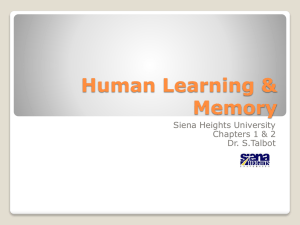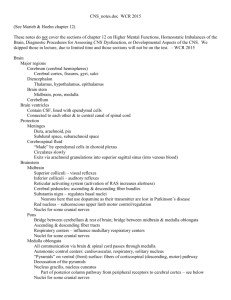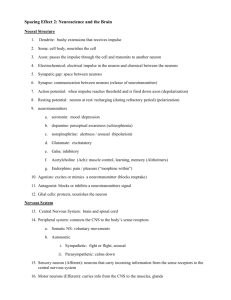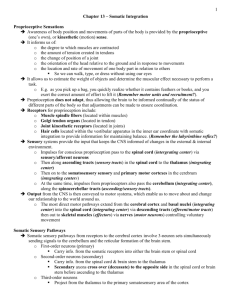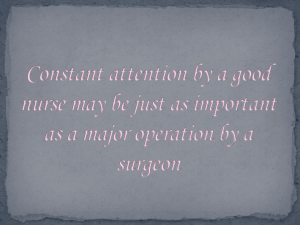14-1 SENSATION FIGURE 14.1 1. The general senses provide
advertisement
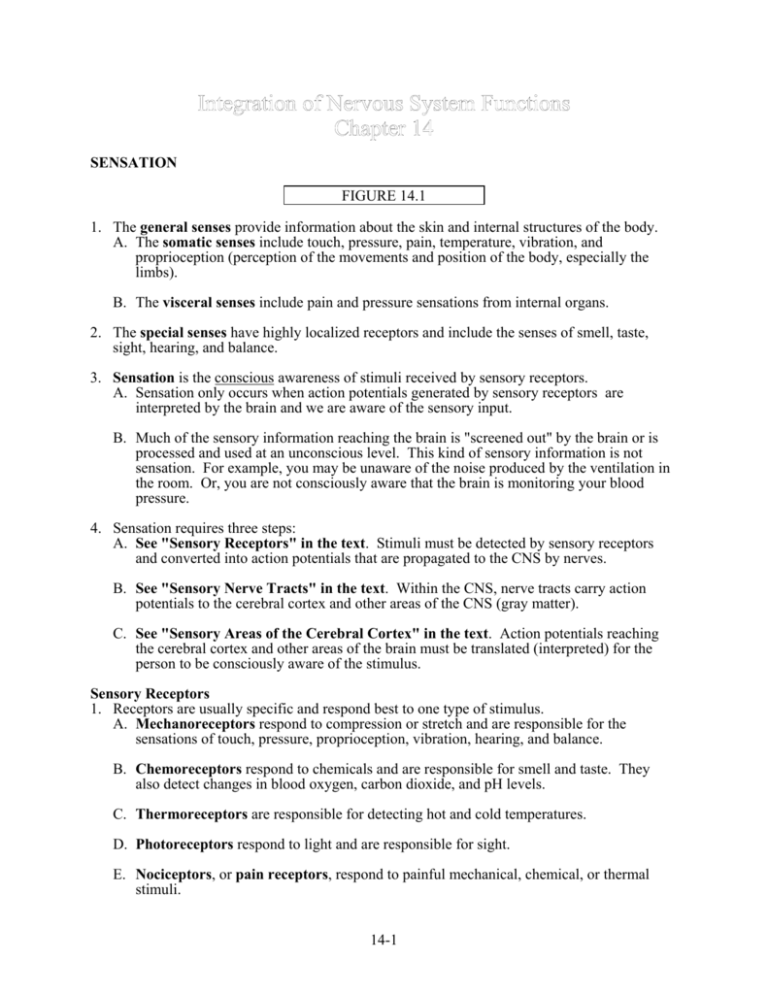
SENSATION FIGURE 14.1 1. The general senses provide information about the skin and internal structures of the body. A. The somatic senses include touch, pressure, pain, temperature, vibration, and proprioception (perception of the movements and position of the body, especially the limbs). B. The visceral senses include pain and pressure sensations from internal organs. 2. The special senses have highly localized receptors and include the senses of smell, taste, sight, hearing, and balance. 3. Sensation is the conscious awareness of stimuli received by sensory receptors. A. Sensation only occurs when action potentials generated by sensory receptors are interpreted by the brain and we are aware of the sensory input. B. Much of the sensory information reaching the brain is "screened out" by the brain or is processed and used at an unconscious level. This kind of sensory information is not sensation. For example, you may be unaware of the noise produced by the ventilation in the room. Or, you are not consciously aware that the brain is monitoring your blood pressure. 4. Sensation requires three steps: A. See "Sensory Receptors" in the text. Stimuli must be detected by sensory receptors and converted into action potentials that are propagated to the CNS by nerves. B. See "Sensory Nerve Tracts" in the text. Within the CNS, nerve tracts carry action potentials to the cerebral cortex and other areas of the CNS (gray matter). C. See "Sensory Areas of the Cerebral Cortex" in the text. Action potentials reaching the cerebral cortex and other areas of the brain must be translated (interpreted) for the person to be consciously aware of the stimulus. Sensory Receptors 1. Receptors are usually specific and respond best to one type of stimulus. A. Mechanoreceptors respond to compression or stretch and are responsible for the sensations of touch, pressure, proprioception, vibration, hearing, and balance. B. Chemoreceptors respond to chemicals and are responsible for smell and taste. They also detect changes in blood oxygen, carbon dioxide, and pH levels. C. Thermoreceptors are responsible for detecting hot and cold temperatures. D. Photoreceptors respond to light and are responsible for sight. E. Nociceptors, or pain receptors, respond to painful mechanical, chemical, or thermal stimuli. 14-1 2. Structure and function go together. Receptors that are specialized to detect specific stimuli are different from each other. FIGURE 14.2 3. IMPORTANT POINT: Different receptors are associated with different sensations. See Table 14.1 to appreciate this fact, but don’t be concerned with matching receptors with functions. Rub your closed eyes and describe the sensations you perceive. What does this tell you about receptor specificity? Sensory Nerve Tracts 1. Location of the spinal nerve tracts. FIGURE 14.7 A. Recall that the white matter of the spinal cord is divided into three columns: the anterior, lateral, and posterior columns (funiculi). B. Each column is divided up into nerve tracts (fasciculi) that ascend or descend the spinal cord. 2. Naming conventions. A. Spinal pathways are often given a composite name. The first part of the name indicates the origin of the tract and the last part of the name indicates where the tract is going. For example, the spinothalamic tract begins in the spinal cord and extends to the thalamus. Remember that almost all sensory input that results in sensation (except for olfaction) passes through the thalamus. B. Sometimes the tract is named according to its location or shape For example, the dorsalcolumn/medial-lemniscal (L. ribbon) system is so name because part of it is in the dorsal column of the spinal cord and part of it looks like a ribbon in the brain. 14-2 The Big Picture 1. Somatic senses have two major origins. A. Cutaneous – provides information about the surface of the body. B. Joints, tendons, and muscles – provides proprioception information (awareness of body position and movements). We are consciously aware of some of the proprioception information, but much of it occurs at an unconscious level. 2. Somatic senses except for the anterior head and face. B. Anterolateral system – the spinothalamic and other tracts 1) pain and temperature 2) light touch, pressure, tickle, and itch sensations C. Dorsal column/medial lemniscal system. 1) two point discrimination, pressure and vibration 2) proprioception D. Spinocerebellar tracts – unconscious proprioception 3. Somatic senses from the anterior head and face. TABLE 13.5. p. 465 A. The trigeminothalamic tract (from cranial nerve V, the trigeminal nerve) B. The same somatic senses as the anterolateral system and the dorsal column/medial lemniscal system. 4. Visceral senses – nerves and tracts of the ANS. 5. Special senses – cranial nerves and associated tracts. Anterolateral System FIGURE 14.7 1. The spinothalamic tract carries pain, temperature, light touch, pressure, tickle, and itch sensations from the skin (except for the anterior head and face). 14-3 2. Light touch is sometimes called crude touch because the ability to localize the stimulus is poor. On the other hand, pain sensations can be very precisely located in the skin. A. For example, if a mosquito lands on the skin, the resulting light touch activates Merkel’s receptors. You probably do not even pay attention to the sensation. B. When the mosquito bites you, free nerve endings are stimulated. You know exactly where the pain is located and you swat the mosquito. C. After a few bites, you start paying more attention to sensations of light touch. A light breeze can set you on a search for a mosquito. You felt something, but are not quite sure what it is or precisely where it is located. 2. Organization of neurons in the spinothalamic tract. FIGURE 14.8 A. The primary neuron cell body is in a dorsal root ganglion. The primary neuron receives sensory input and conducts it to the spinal cord. B. The secondary neuron cell body is in the posterior horn of the spinal cord gray matter. 1) There are interneurons between the primary and secondary neurons but they are not usually named. 2) The secondary neuron crosses to the opposite side of the spinal cord and ascends to the thalamus. C. The tertiary neuron cell body is in the thalamus. It synapses with the secondary neuron and its axon extends to the somatic sensory cortex, the part of the cerebral cortex where sensation occurs. Which side of the brain receives pain input from the right side of the body? Explain. Would a lesion of the spinothalamic tract on the left side of the spinal cord cause a loss of sensation on the left or right side of the body? Explain. 14-4 Dorsal-Column/Medial-Lemniscal System 1. Function. The dorsal-column/medial-lemniscal system is responsible for conscious and unconscious proprioception, two-point discrimination (the ability to detect simultaneous stimulation of two points of the skin), pressure, and vibration. Two-point discrimination is also called fine touch. FIGURE 14.3 Note that 2mm = 1/16 in; 4mm = 1/8 in; 64mm = 2.5 in. 2. Organization of neurons in the dorsal-column/medial-lemniscal system. FIGURE 14.9 A. The primary neuron cell body is a dorsal root ganglion. The axon of the primary neuron enters the spinal cord and ascends to the medulla oblongata without crossing over. The axons of the primary neurons form the dorsal columns, also called the posterior columns or posterior funiculi. B. The secondary neuron is in a nucleus in the medulla oblongata. The primary neuron synapses with the secondary neuron, which crosses over in the medulla and ascends to the thalamus. The axons of the secondary neurons form the medial lemniscus (a nerve tract). C. The tertiary neuron cell body is in the thalamus. The secondary neuron synapses with the tertiary neuron and the tertiary neuron axon extends to the somatic sensory cortex. Would a lesion of the dorsal-column/medial-lemniscal system in the spinal cord cause loss of proprioception, fine touch, and vibration on the same side of the body, or on the opposite side of the body, below the level of the lesion? Explain. Would a lesion of the dorsal-column/medial-lemniscal system in the brainstem superior to the medulla cause the loss of proprioception, fine touch, and vibration on the same side of the body, or on the opposite side of the body, below the level of the lesion? Explain. 14-5 Common characteristics of the spinothalamic and dorsal-column/medial-lemniscal tracts. 1. All of these tracts involve three neurons. 2. All of these tracts synapse in the thalamus. 3. All of these tracts cross over from one side of the body to the other side (but in different locations). Memory aid: SPINOthalamic tract crosses over in the SPINAL cord. Dorsal-column/Medial lemniscal system crosses over in the Medulla Spinocerebellar Tracts FIGURE 14.10 1. Function. A. The spinocerebellar tracts carry unconscious proprioception to the cerebellum from the trunk and lower limbs. B. The dorsal-column/medial-lemniscal system carries unconscious proprioception to the cerebellum from the upper limbs. C. The cranial nerves and their pathways carry unconscious proprioception to the cerebellum from the head. 2. Organization of neurons in the spinocerebellar tracts. A. In the spinocerebellar tracts the primary neurons enter the spinal cord and synapse with secondary neurons. 1) In the posterior spinocerebellar tract the secondary neurons ascend to the cerebellum on the same side. 2) In the anterior spinocerebellar tract the secondary neurons cross over in the spinal cord then cross back over in the cerebellum. B. Each hemisphere of the cerebellum receives proprioceptive information from the same side of the body. 14-6 Descending Pathways Modifying Sensation 1. Certain descending pathways send collateral branches to the thalamus, reticular formation, trigeminal nuclei, and spinal cord. 2. Certain descending tracts can inhibit ascending sensory tracts and decrease sensations such as pain. Sensory Areas of the Cerebral Cortex FIGURE 14.11 1. Primary sensory areas are the areas of the cerebral cortex to which sensory nerve tracts project. 2. The primary visual cortex is in the occipital lobe, the primary auditory cortex is in the lateral temporal lobe, the olfactory cortex is in the inferior frontal lobe (“behind” the temporal lobe), and the taste area is in the parietal lobe. 3. The primary somatic sensory cortex (G. body sensation) is found in the postcentral gyrus (the ridge immediately posterior to the central sulcus) of the parietal lobe. A. Conscious sensations for pain, pressure, temperature, and proprioception occur in the primary somatic sensory cortex. B. Projection is perception of sensations in a body part (such as the skin) even though the action potentials are occurring in the cerebral cortex. C. Specific areas of the primary somatic sensory cortex correspond to specific areas of the body. FIGURE 14.12 Why do you think some areas of the body are represented by such large areas of the primary somatic sensory cortex? 4. Association areas are regions of the cortex immediately adjacent to primary sensory areas. FIGURE 14.11 14-7 A. The primary sensory areas are concerned with the basic interpretation of stimuli. For example, the primary visual cortex interprets the shape of an object or its color. B. The association areas are involved with evaluating the stimuli and relating the stimuli to past experience. For example, the visual association area determines if an object is someone's face and if it is the face of a friend or a stranger. CONTROL OF SKELETAL MUSCLES 1. Contraction of skeletal muscles can result from conscious, voluntary control or unconscious, involuntary reflexes (mediated through the brainstem or spinal cord). 2. Voluntary control can initiate movements, but then many of the details of the movement are controlled through neural circuits and reflexes. For example, one can voluntarily start walking, but then one does not have to "think" about all the details of muscle control necessary for walking. 3. Upper and lower motor neurons are involved with voluntary control of skeletal muscles. A. Upper motor neurons are in the cerebral cortex. Upper motor neurons synapse directly, or through interneurons (not named), to lower motor neurons. B. Lower motor neurons are in cranial nerve nuclei or the anterior horns of the spinal cord gray matter. The axons of lower motor neurons are part of the cranial and spinal nerves and they extend to skeletal muscles. 4. Voluntary movements depend upon three steps: A. See "Motor Areas of the Cerebral Cortex" in the text. Initiation of most voluntary movements takes place in the premotor areas of the cerebral cortex. B. See "Motor Nerve Tracts" in the text. Descending nerve tracts from the cerebral cortex and other parts of the brain stimulate lower motor neurons. C. See "Modifying and Refining Motor Activities" in the text. The cerebral cortex interacts with the basal nuclei and cerebellum in the planning, coordination, and execution of movements. Motor Areas of the Cerebral Cortex 1. The primary motor cortex is found in the precentral gyrus (the ridge immediately anterior to the central sulcus). FIGURE 14.13 A. Voluntary control of skeletal muscles occurs (in part) in the primary motor area. B. Specific areas of the primary motor area correspond to specific areas of the body. 14-8 Why are some areas of the body represented by large areas of the primary motor area, whereas others are represented by small areas? 2. The premotor area is located just anterior to the primary motor area and is involved with voluntary skeletal muscle movement. FIGURE 14.11 A. The premotor area is the staging area where motor functions are organized. For example, if a person is about to take a step, the premotor area determines which muscles contract, the order of contraction, and the amount of contraction. B. Neurons in the premotor area stimulate upper motor neurons, which stimulate lower motor neurons, which stimulate skeletal muscles to contract. C. About 30% of upper motor neurons are in the premotor area, 30% in the primary motor cortex, and 40% are in the somatic sensory cortex. Note that the brain is more complex than the names of different parts of the cortex indicate. There is no complete segregation of sensory and motor neurons. D. Damage to the premotor area can result in apraxia (G. not to do). In this disorder individual muscle movements are possible, but they cannot be put together to perform complex movements. 3. The prefrontal area is located anterior to the premotor area. FIGURE 14.11 A. The motivation and the foresight to plan and initiate movements occur here. B. Movements can be initiated in the prefrontal area, organized in the premotor area, and implemented in the primary motor area. Simplistic summary: Prefrontal area = I want to do this; Premotor area = Here’s how to do it; Primary motor cortex (upper motor neurons) = Do it. C. The prefrontal areas are also involved with thought, intelligence (the ability to do sequential analysis), conscience (the ability to understand the consequences of actions), personality, and mood. A prefrontal or frontal lobotomy was once used to control aggressive behavior. However it also resulted in undesirable personality changes, such as lack of initiative or loss of a conscience. 14-9 Motor Nerve Tracts 1. The axons of neurons form the descending motor nerve tracts. The names of the tracts provide information about the origin and destination of the tracts. For example, the corticospinal tract begins in the cerebral cortex and extends to the spinal cord. FIGURE 14.14 2. The descending motor tracts are divided into direct and indirect pathways. A. Both pathways control voluntary skeletal muscle activity. 1) The indirect pathways are considered to be the older, more “primitive” pathways. The direct pathways are found only in mammals, and are most developed in primates. 2) The indirect pathways in humans are involved with the trunk and proximal limbs. They are involved with maintaining posture and balance, positioning of the limbs (e.g., position of the upper limbs while attempting to thread a needle), general body movements, and unconscious stereotypic movements (e.g., the limbs while walking). 3) The direct pathways are very involved with the distal limbs and face. They are responsible for the fine control of the hands (dexterity) and facial muscles (facial expressions). It is believed that the direct pathways are superimposed over the indirect pathways. B. Both pathways can increase muscle tone. In addition, some indirect pathways decrease muscle tone. C. The direct pathways are sometimes called the pyramidal system, and the indirect pathways are sometimes called the extrapyramidal system. Direct Pathways FIGURES 14.15 1. The direct pathways are formed by the axons of upper motor neurons located in the cerebral cortex. The direct pathways are so called because the axons of the upper motor neurons go “directly” to lower motor neurons in cranial nerve nuclei or the spinal cord. 2. The direct pathways consist of two nerve tracts. A. The corticobulbar tracts supply the cranial nerves. 14-10 B. The corticospinal tracts supply the spinal nerves. FIGURE 14.16 1) The axons of the upper motor neurons from the cerebral cortex extend through the internal capsule, which is formed by descending motor nerve tracts from the cerebrum and ascending sensory nerve tracts from the thalamus. 2) The axons of the upper motor neurons pass through the midbrain (cerebral peduncles) and pons to the medulla oblongata (pyramids), forming much of the anterior side of the brainstem. 3) About 20% of the axons descend down the same side (do not cross over) forming the anterior corticospinal tract. In the spinal cord the upper motor cross over to the opposite side of the cord and synapse with lower motor neurons, which extend to the muscles. The anterior corticospinal tract extends only to the level of the midthorax. 4) About 80% of the axons cross over to the opposite side in the medulla through the pyramidal decussation. After crossing over the axons descend in the spinal cord, forming the lateral corticospinal tract. In the spinal cord, the upper motor neurons synapse with lower motor neurons, which extend to the muscles. C. The corticobulbar tracts supply mainly the head and throat, but also a neck and a back muscle; the anterior corticospinal tracts supply the neck, upper thorax, and upper limbs; and the lateral corticospinal tract supplies the neck and all parts of the body inferior to the neck. D. Common characteristics of the corticospinal tracts. 1) The corticospinal tracts cross over to the opposite side of the body (but in different locations). Importance: each half of the brain controls the opposite side of the body. 2) Both tracts involve two neurons. Indirect Pathways FIGURE 14.15 and 14.17 1. In the indirect pathways, neurons in the cerebral cortex or cerebellum can affect lower motor neurons, but do so indirectly. The axons from these neurons form nerve tracts that extend to nuclei in the brainstem. There, the axons synapse with the neurons that form the nuclei. The axons from the nuclei form the indirect nerve tracts that extend to the lower motor neurons. Thus, there is no direct connection between cortical and spinal neurons. 14-11 2. Input to the brainstem nuclei: A. Motor neurons from the motor cortex. B. Collateral branches from the upper motor neurons of the direct pathways. C. Minor input is from the cerebellum and the basal nuclei (more later). 3. The axons of the brainstem nuclei extend into the spinal cord as the rubrospinal tract (related to cerebellar functions), vestibulospinal tract (maintains posture by innervating extensor muscles), reticulospinal tract (controls large movements of the trunk and limbs), and others. Clinical Applications 1. Damage to the spinal cord or brain can produce serious dysfunctions because of interruption of nerve tracts. The most dramatic loss of function involves control of voluntary motor activity. 2. Damage to the spinal cord results in flaccid paralysis. Following recovery from spinal shock, reflex activity below the level of injury can return. A. Usually spinal cord injuries damage both the direct and indirect pathways, resulting in complete flaccid paralysis. This is the case we will usually consider. B. Very rarely damage to just the corticospinal tracts in the spinal cord can occur. In these cases, there is only partial loss of function. The limbs can be moved, but fine movement (e.g., the ability to grasp and manipulate objects) is lost. Apparently the indirect pathways are able to compensate for much of the function lost by damaging the corticospinal tract in the spinal cord. 3. Damage to the direct and indirect pathways in the brain typically results in spastic paralysis. A. Damage usually results from a stroke involving the cerebral motor areas or the internal capsule. B. The cerebral cortex normally exerts an inhibitory effect on the reticular formation in the brainstem. The reticular formation normally has an excitatory effect on skeletal muscles. Therefore, damage to the cerebral cortex or the pathways superior to the brainstem can result in overexcitation of skeletal muscle. C. Observed symptoms. 1) Immediately following the injury there is a period of flaccid paralysis, which is analogous to spinal shock. 2). After a few days to weeks, muscle tone and reflexes return and increase. Hypertonia and hyperreflexia result in spastic paralysis, especially in the flexors of the upper limb and the extensors of the lower limb. 14-12 4. Simplified diagrams of the major spinal pathways are provided for you. Use them to understand clinical problems relating to nerve tract damage. Problems 1. If the anterolateral system (spinothalamic tract) on the right side of the spinal cord was severed, a. pain sensations below the damaged area on the right side would be eliminated. b. pain sensations below the damaged area on the left side would be eliminated. c. temperature sensation would be unaffected. d. none of the above 2. A person with a spinal cord injury is suffering from paralysis of her right lower limb. Which of the following spinal pathways is probably involved? a. left lateral corticospinal tract b. right lateral corticospinal tract c. spinocerebellar tracts d. left dorsal-column/medial-lemniscal system e. right dorsal-column/medial-lemniscal system 3. Given the following symptoms: 1. nearly all motor functions were disrupted below the injury on the right side 2. sensations of fine touch and pressure were lost below the injury on the right side 3. sensations of pain and temperature were lost on the left side below the injury 4. light touch is normal on the right side below the injury Which of the symptoms are consistent with the unilateral transection of the spinal cord on the right side of the body? a. 1, 2, 3, 4 b. 2, 3, 4 c. 1, 2, 3 d. 1, 2, 4 e. 1, 3, 4 4. A patient suffered a lesion in the center of the spinal cord. It was suspected that the fibers that decussate (cross over) and are associated with the lateral spinothalamic tract were affected in the area of the lesion. What observations would be consistent with that diagnosis? 14-13 Modifying and Refining Motor Activities Basal Nuclei FIGURE 13.10, p. 455 1. The basal nuclei are a group of nuclei found in the cerebrum (corpus striatum), diencephalon (subthalamic nucleus), and midbrain (substantia nigra). 2. The basal nuclei are interconnected with the cerebral cortex. Motor output Cerebral cortex Corpus striatum Subthalamic nuclei Substantia nigra Thalamus A. The cerebral cortex controls motor output by sending action potentials to the neurons that supply skeletal muscles. B. The motor output is modified by the activities of the basal nuclei. 1) Information from the cerebral cortex about movements is sent to the basal nuclei. 2) The basal nuclei respond to the information and send feedback information through the thalamus back to the cerebral cortex. There are many, complex circuits between the cerebral cortex and the basal nuclei. 3) The circuits have an excitatory effect on some cerebral cortex areas and an inhibitory effect on others. Often, the excitatory and inhibitory circuits work together to promote movement. For example, excitatory circuits promote the contraction of muscles and the inhibitory circuits promote the relaxation of antagonist muscles. 4) Normal movements are achieved by the appropriate balance between the excitatory and inhibitory circuits. Too much excitatory effects or inhibitory effects produce dysfunctions. 14-14 Parkinson's Disease Excitatory Circuits Promote movement by facilitating the contraction of muscles. Especially important at the beginning of a movement. Inhibitory Circuits Decrease muscle tone. Huntington's Disease and Hemiballismus Decreased excitatory effects Increased excitatory effects on on the cerebral cortex result in the cerebral cortex result in difficulty in initiating involuntary movements. movements. For example, it is difficult to rise from a sitting position or initiate walking. Decreased inhibitory effects result in tremors at rest and rigidity (increased muscle tone). Increased inhibitory effects result in decreased muscle tone. 3. Parkinson's disease is the most common basal nuclei disorder. It results from decreased dopamine secretion by the substantia nigra. A. Parkinson disease can be treated with L-dopa, which crosses the blood-brain barrier and is converted into dopamine. This helps to restore the normal function of the basal nuclei circuits. B. Surgical intervention to destroy certain parts of the basal nuclei or the implantation of devices that electrically stimulate parts of the basal nuclei are used to treat Parkinson disease. 4. Huntington’s disease is a dominant hereditary disorder that begins between the ages of 30 to 50 years. It is characterized by a series of rapid, nearly continuous, involuntary movements of the limbs and facial muscles. The symptoms gradually become worse and are accompanied by gradually developing dementia. 5. Hemiballismus (G. jumping about), caused by a stroke, results in wild flailing movements of one arm and one leg. 14-15 Cerebellum FIGURE 13.6, p. 450 1. The vestibulocerebellum or the flocculonodular lobe helps to maintain posture, control balance during movements, and coordinate eye movements. It receives input from the inner ear (see chapter 15), which detects movements of the head. 2. The spinocerebellum consists of the vermis and the adjacent part of the lateral hemispheres. The spinocerebellum functions as a comparator, which means it compares intended movements to actual movements. The comparator function works to coordinate simple movements like touching your nose. FIGURE 14.18 A. Action potentials from the cerebral motor cortex go to skeletal muscles and the cerebellum. B. Unconscious input from the muscles and joints (proprioception) also goes to the cerebellum. C The cerebellum compares the intended movement with the actual movement. Correction signals (if needed) are send to the cerebral motor cortex and the spinal cord. Cerebral cortex Spinal cord What muscle should do Muscle Proprioceptors Cerebellum What muscle does 14-16 Correction signal Alcohol has a significant effect on cerebellum function. Explain the rationale for roadside sobriety tests. A patient has a cerebellar lesion. As he attempts to drink a glass of water, the closer the glass gets to his lips the more his hand shakes. Explain what is happening. 3. The cerebrocerebellum consists of the lateral two-thirds of the lateral hemispheres. A. The cerebrocerebellum is involved with rapid, complex movements that occur more rapidly than could be accomplished by the comparator function of the spinocerebellum. For example, playing the piano or swinging a bat. B. The cerebrocerebellum is in constant communication with the cerebral cortex and helps in the planning and execution of movements. Through training, a person can learn highly skilled rapid movements. Other Brain Functions Speech FIGURE 14.11 1. Wernicke's area (sensory speech area) is necessary for understanding and formulating coherent speech. 2. Broca's area (motor speech area) controls the sequence of muscle contractions necessary to produce a spoken word. 3. In most people Wernicke's and Broca's areas occur only in the left cerebral hemisphere. 14-17 4. An example of seeing a word and then saying the word. FIGURE 14.20 A. The image of the word is "seen" by the primary visual cortex, e.g., the size and shape of the letters in the word. B. In the visual association area the image is recognized as a word. C. In Wernicke's area the meaning of the word is understood. D. In Broca's area the sequence of commands necessary to say the word are formulated. E. In the premotor area the movements necessary to speak the word are organized. F. In the primary motor area the movements are initiated. 5. Aphasia (G. without speech) can result from disorders of the speech areas. In receptive aphasia the patient is unable to understand spoken or written words, or is unable to correctly name objects. In which speech area is there a defect? In expressive aphasia the patients know what they want to say, but they have hesitant or distorted speech, or are unable to say the word. In which speech area is there a defect? Right and Left Cerebral Cortex 1. Each cerebral hemisphere receives sensory information from the opposite side of the body and controls motor activities on the opposite side of the body. 2. The two cerebral hemispheres communicate with each other through commissural tracts, the largest of which is the corpus callosum. This allows for the integration of sensory information and the coordination of muscle activities. 3. Some functions are not shared equally between the cerebral hemispheres. A. The left cerebral hemisphere is more involved with speech and mathematics. B. The right cerebral hemisphere is more involved with three-dimensional (spatial) perception, recognition of faces, and musical abilities. C. For most functions, cerebral dominance is not important because the two hemispheres are in constant communication with each other through the corpus callosum. For Your Own Information See the sections on Brainstem Functions, Memory, the Limbic System, and the Effects of Aging on the Nervous System. 14-18

